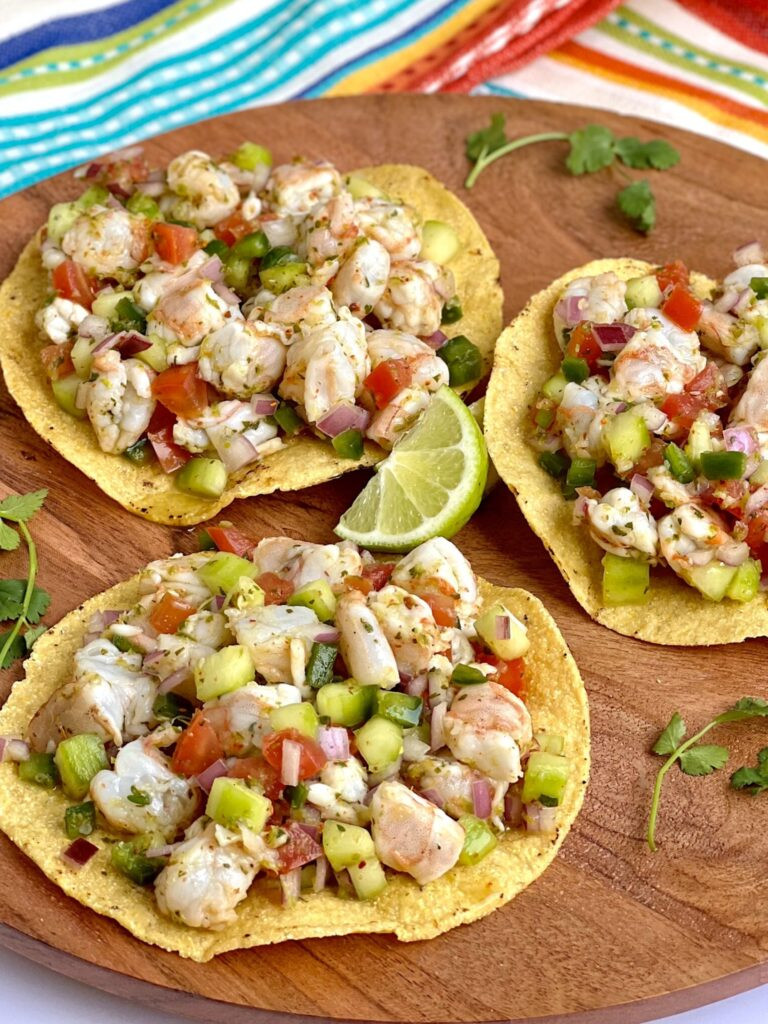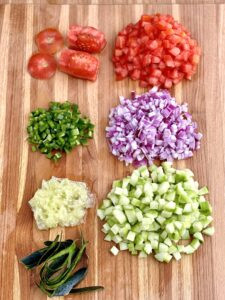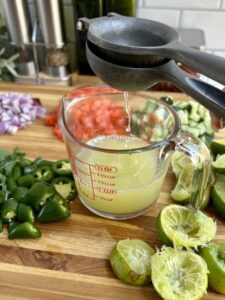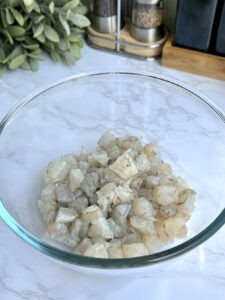Craving a taste of Mexico? Shrimp ceviche Mexican style is a vibrant and refreshing dish perfect for warm weather or any time you want a burst of flavor. At gaymexico.net, we’re passionate about sharing the best of Mexican culture, including its incredible cuisine. This guide will show you how to create authentic shrimp ceviche that will impress your friends and family, offering a delightful culinary experience with a touch of Mexican flair. Get ready to dive into the zesty world of citrus-cured seafood with this easy-to-follow recipe.
1. What is Mexican Shrimp Ceviche and Why is it So Popular?
Mexican shrimp ceviche is a seafood dish where raw shrimp is “cooked” using the acidity of citrus juices, typically lime and lemon. It’s immensely popular because of its fresh, tangy taste, ease of preparation, and versatility as an appetizer or light meal. The combination of tender shrimp, zesty citrus, and crisp vegetables makes it a crowd-pleaser, especially among the LGBTQ+ community and their allies who appreciate vibrant and shareable dishes.
1.1 A Brief History of Ceviche
Ceviche’s origins can be traced back to ancient Peru, where the indigenous people marinated fish in fruit juices. Over time, the dish evolved and spread throughout Latin America, with each country adding its own unique twist. Mexican ceviche distinguishes itself with the use of ingredients like jalapeños, cilantro, and sometimes Clamato juice, creating a bold and spicy flavor profile.
1.2 Why Shrimp Ceviche is a Great Choice
Shrimp is a fantastic choice for ceviche because it cooks quickly in the citrus marinade and absorbs flavors beautifully. It’s also readily available and relatively affordable, making it an accessible option for home cooks. Plus, it’s a healthy and delicious way to enjoy seafood.
2. What are the Key Ingredients for Authentic Mexican Shrimp Ceviche?
To make truly authentic Mexican shrimp ceviche, you’ll need:
- Fresh Shrimp: The star of the show! Look for high-quality, raw shrimp that is firm and smells fresh.
- Lime Juice: Freshly squeezed lime juice is essential for “cooking” the shrimp and providing that signature tangy flavor.
- Lemon Juice: A little lemon juice adds complexity and enhances the citrusy notes.
- Tomato: Diced tomatoes add sweetness and texture.
- Red Onion: Thinly sliced red onion provides a sharp, pungent flavor.
- Cilantro: Fresh cilantro is a must for its bright, herbaceous flavor.
- Jalapeño: For a touch of heat, finely chopped jalapeño peppers are key.
- Cucumber: Diced cucumber adds a refreshing crunch.
- Avocado: Creamy avocado is the perfect topping, balancing the acidity of the ceviche.
- Tajin (Optional): This popular Mexican seasoning adds a unique blend of chili, lime, and salt.
- Clamato Juice (Optional): Some recipes use Clamato juice for a touch of sweetness and umami.
- Salt and Pepper: To taste.
 Fresh Ingredients for Shrimp Ceviche
Fresh Ingredients for Shrimp Ceviche
A vibrant display of fresh shrimp ceviche ingredients, showcasing the key components for a zesty and authentic Mexican flavor.
3. Step-by-Step Guide: How to Prepare Shrimp Ceviche Mexican Style
Follow these simple steps to create mouthwatering shrimp ceviche:
3.1 Preparing the Shrimp
- Clean the Shrimp: Rinse the shrimp under cold water and pat them dry.
- Devein the Shrimp: Remove the dark vein running along the back of the shrimp.
- Chop the Shrimp: Cut the shrimp into small, bite-sized pieces. This helps them “cook” more evenly and makes them easier to eat.
3.2 Marinating the Shrimp
- Combine Citrus Juices: In a glass bowl, combine the fresh lime juice and lemon juice. Make sure there’s enough juice to fully submerge the shrimp.
- Marinate the Shrimp: Add the chopped shrimp to the citrus juice mixture. Stir well to ensure all the shrimp is coated.
- Refrigerate: Cover the bowl and refrigerate for at least 30 minutes, or until the shrimp turns pink and opaque. The longer it marinates, the firmer the shrimp will become.
3.3 Adding the Vegetables and Seasonings
- Prepare the Vegetables: While the shrimp is marinating, dice the tomatoes, red onion, cucumber, and jalapeño. Chop the cilantro.
- Combine Ingredients: Once the shrimp is “cooked,” drain the excess citrus juice. Add the diced vegetables, cilantro, and Tajin or Clamato juice (if using) to the bowl.
- Season to Taste: Season with salt and pepper to taste.
- Mix Gently: Gently mix all the ingredients together until well combined.
3.4 Serving the Ceviche
- Chill: Refrigerate the ceviche for another 15-30 minutes to allow the flavors to meld.
- Serve: Serve the shrimp ceviche chilled, topped with slices of creamy avocado.
- Enjoy: Enjoy your delicious homemade Mexican shrimp ceviche with tostadas, tortilla chips, or saltine crackers.
4. Tips and Tricks for the Best Shrimp Ceviche
- Use the Freshest Shrimp Possible: The quality of the shrimp is crucial for the taste and safety of the ceviche.
- Don’t Over-Marinate: Over-marinating can make the shrimp tough and rubbery. Check for doneness after 30 minutes and adjust the time accordingly.
- Remove Seeds: Removing the seeds from the tomatoes, cucumber, and jalapeño can help prevent the ceviche from becoming too watery.
- Adjust the Spice Level: If you prefer a milder ceviche, use less jalapeño or remove the seeds and membranes before chopping.
- Add Avocado Just Before Serving: Adding avocado too early can cause it to become mushy. It’s best to add it as a topping just before serving.
5. Variations and Creative Twists on Shrimp Ceviche
While the classic recipe is delicious, there are many ways to customize your shrimp ceviche:
- Add Mango or Pineapple: For a sweet and tropical twist, add diced mango or pineapple to the ceviche.
- Use Different Types of Peppers: Experiment with different types of peppers, such as serrano or habanero, for varying levels of heat.
- Include Other Seafood: Mix shrimp with other seafood, such as white fish, scallops, or octopus, for a more complex flavor.
- Vegan Ceviche: For a vegan option, substitute shrimp with hearts of palm or mushrooms.
- Aguachile Style: Add blended serrano peppers with cilantro and lime juice for a spicier marinade, similar to aguachile.
 Preparing Tomatoes and Onions
Preparing Tomatoes and Onions
Dicing fresh tomatoes, a colorful component that adds sweetness and texture to authentic Mexican shrimp ceviche.
6. Health Benefits of Eating Shrimp Ceviche
Shrimp ceviche is not only delicious but also offers several health benefits:
- High in Protein: Shrimp is a great source of lean protein, which is essential for building and repairing tissues.
- Rich in Omega-3 Fatty Acids: Omega-3 fatty acids are important for heart health and brain function.
- Good Source of Vitamins and Minerals: Shrimp contains vitamins B12 and D, as well as minerals like selenium and iron.
- Low in Calories: Ceviche is a relatively low-calorie dish, making it a great option for those watching their weight.
- Citrus Benefits: The lime and lemon juice provide Vitamin C and antioxidants.
7. How to Serve Shrimp Ceviche for a Party or Gathering
Shrimp ceviche is an excellent choice for parties and gatherings, especially for the LGBTQ+ community who enjoy sharing flavorful and visually appealing dishes. Here are some serving suggestions:
- Tostada Bar: Set up a tostada bar with tostada shells, shrimp ceviche, avocado, hot sauce, and other toppings, allowing guests to create their own custom ceviche tostadas.
- Ceviche Spoons: Serve individual portions of ceviche in small spoons for an elegant and easy-to-eat appetizer.
- Martini Glasses: Present the ceviche in martini glasses for a sophisticated and festive presentation.
- As Part of a Mexican Fiesta: Include shrimp ceviche as part of a larger Mexican-themed spread, along with other dishes like tacos, guacamole, and salsa.
8. Pairing Shrimp Ceviche with Drinks
The bright, citrusy flavors of shrimp ceviche pair well with a variety of drinks:
- Margaritas: A classic choice! The tangy lime in a margarita complements the flavors of the ceviche perfectly.
- Micheladas: A Mexican beer cocktail with lime juice, hot sauce, and spices. The savory and spicy flavors of a Michelada pair well with the freshness of the ceviche.
- Mexican Beer: Light and refreshing Mexican beers like Corona or Modelo are great choices.
- White Wine: Crisp white wines like Sauvignon Blanc or Pinot Grigio can also be a good match.
- Non-Alcoholic Options: Sparkling water with lime, or agua fresca (fruit-infused water), are refreshing non-alcoholic options.
9. The Importance of Food Safety When Making Ceviche
Since ceviche involves “cooking” raw shrimp with citrus juice, it’s important to take food safety precautions:
- Buy High-Quality Shrimp: Purchase shrimp from a reputable source and ensure it is fresh and properly refrigerated.
- Marinate Properly: Make sure the shrimp is fully submerged in the citrus juice and marinate it for an adequate amount of time (at least 30 minutes) to kill any harmful bacteria.
- Keep it Cold: Store the ceviche in the refrigerator at all times to prevent bacterial growth.
- Consume Promptly: Eat the ceviche within 1-2 days of making it, as the texture and flavor can deteriorate over time.
 Squeezing Fresh Limes
Squeezing Fresh Limes
The essence of ceviche: freshly squeezed lime juice, vital for curing the shrimp and infusing the dish with its signature tang.
10. Discovering LGBTQ+ Friendly Culinary Experiences in Mexico
Mexico is increasingly becoming a popular destination for LGBTQ+ travelers, and many cities offer welcoming culinary experiences:
- Puerto Vallarta: Known for its vibrant gay scene, Puerto Vallarta offers numerous restaurants and cooking classes that cater to the LGBTQ+ community.
- Mexico City: The capital city boasts a diverse culinary scene, with many LGBTQ+-owned or friendly establishments.
- Guadalajara: This city is known for its traditional Mexican cuisine and its growing LGBTQ+ presence.
- Oaxaca: Famous for its unique regional cuisine, Oaxaca offers a range of culinary experiences, from street food tours to cooking classes.
Explore gaymexico.net for more information on LGBTQ+ friendly destinations and events in Mexico.
11. LGBTQ+ Community and the Love for Mexican Cuisine
The LGBTQ+ community often embraces and celebrates diverse cultures, and Mexican cuisine is no exception. The vibrant flavors, communal dining traditions, and festive atmosphere of Mexican food resonate with the community’s values of inclusivity and celebration.
11.1 Shared Meals and Community
Mexican cuisine is often enjoyed in a communal setting, with large portions meant to be shared among friends and family. This aligns with the LGBTQ+ community’s emphasis on building strong social connections and chosen families.
11.2 Celebrating Diversity Through Flavors
The diverse range of flavors and ingredients in Mexican cuisine reflects the LGBTQ+ community’s appreciation for diversity and individuality.
11.3 Food as a Form of Expression
For many in the LGBTQ+ community, food is a form of self-expression and creativity. Experimenting with different recipes and flavors allows individuals to showcase their unique personalities and culinary talents.
12. Supporting LGBTQ+ Owned Businesses in Mexico
When traveling in Mexico, consider supporting LGBTQ+-owned businesses:
- Restaurants and Bars: Patronize restaurants and bars that are owned and operated by members of the LGBTQ+ community.
- Hotels and Accommodations: Choose LGBTQ+-friendly hotels and accommodations that prioritize inclusivity and respect.
- Tour Operators: Book tours and activities with LGBTQ+-owned tour operators who can provide unique and authentic experiences.
- Art Galleries and Shops: Support LGBTQ+ artists and artisans by purchasing their work.
Supporting these businesses helps to promote economic empowerment and visibility for the LGBTQ+ community in Mexico.
13. Where to Find the Best Shrimp Ceviche in Mexico (and Beyond)
While making your own shrimp ceviche is rewarding, sometimes you want to experience the creations of talented chefs. Here are some places to find exceptional shrimp ceviche:
- Coastal Regions of Mexico: Coastal cities like Puerto Vallarta, Cancun, and Tulum are known for their fresh seafood and delicious ceviche.
- Mexican Restaurants in the US: Many Mexican restaurants in the United States, especially in cities with large Mexican communities like Los Angeles, offer authentic and flavorful shrimp ceviche. Check out local reviews and recommendations to find the best spots.
- Seafood Markets: Some seafood markets prepare ceviche fresh daily. This is a great option for a quick and tasty meal.
14. Common Mistakes to Avoid When Making Shrimp Ceviche
- Using Low-Quality Shrimp: The quality of the shrimp is paramount. Don’t skimp on this ingredient.
- Not Marinating Long Enough: Insufficient marinating can leave the shrimp tasting raw and increase the risk of foodborne illness.
- Over-Marinating: As mentioned earlier, over-marinating can make the shrimp tough and rubbery.
- Using Bottled Lime Juice: Freshly squeezed lime juice is essential for the best flavor. Bottled lime juice often contains preservatives and lacks the bright, tangy taste of fresh juice.
- Adding Too Many Ingredients: Keep the recipe simple and focus on the quality of the key ingredients.
- Forgetting to Season: Don’t forget to season the ceviche with salt and pepper to taste.
 Blending Cilantro and Serrano Peppers
Blending Cilantro and Serrano Peppers
Blending cilantro and serrano peppers to create a flavorful base, adding a spicy kick to authentic Mexican shrimp ceviche.
15. How to Store Leftover Shrimp Ceviche
If you have leftover shrimp ceviche, store it in an airtight container in the refrigerator. It’s best to consume it within 1-2 days, as the texture and flavor can deteriorate over time. Be aware that the shrimp will continue to “cook” in the citrus juice, so it may become firmer over time.
16. The Role of Citrus in “Cooking” Seafood
The magic of ceviche lies in the ability of citrus juice to “cook” seafood without heat. This process is called denaturation, where the acid in the citrus juice breaks down the proteins in the shrimp, causing it to firm up and change color, similar to what happens when cooking with heat.
16.1 The Science Behind Denaturation
Denaturation occurs when the structure of proteins is altered, causing them to unfold and lose their original shape. In the case of ceviche, the citric acid in the lime and lemon juice disrupts the protein structure in the shrimp, causing it to coagulate and become opaque.
16.2 Ensuring Food Safety Through Proper Marination
While citrus juice can help to kill some bacteria, it’s important to ensure that the shrimp is properly marinated for an adequate amount of time to minimize the risk of foodborne illness.
17. Connecting with the LGBTQ+ Community in Mexico
Traveling to Mexico as an LGBTQ+ individual can be an enriching experience. Here are some ways to connect with the local LGBTQ+ community:
- Visit LGBTQ+ Bars and Clubs: Many cities in Mexico have thriving LGBTQ+ nightlife scenes.
- Attend LGBTQ+ Events and Festivals: Look for LGBTQ+ events and festivals happening during your visit.
- Join LGBTQ+ Social Groups: Connect with local LGBTQ+ social groups through online platforms or community centers.
- Volunteer with LGBTQ+ Organizations: Volunteer your time with LGBTQ+ organizations to support their work and connect with local activists.
18. Shrimp Ceviche: A Culinary Reflection of Mexican Culture
Shrimp ceviche is more than just a dish; it’s a reflection of Mexican culture and culinary traditions.
18.1 Fresh Ingredients and Vibrant Flavors
The use of fresh, locally sourced ingredients and vibrant flavors reflects the importance of seasonality and regionality in Mexican cuisine.
18.2 Communal Dining and Celebration
Ceviche is often enjoyed in a communal setting, with family and friends gathering around the table to share a meal. This reflects the importance of community and celebration in Mexican culture.
18.3 A Fusion of Influences
Ceviche is a fusion of indigenous and European influences, showcasing the rich history and cultural diversity of Mexico.
19. Explore More Mexican Recipes
Once you’ve mastered shrimp ceviche, explore other delicious Mexican recipes:
- Tacos: A staple of Mexican cuisine, tacos offer endless variations with different fillings and toppings.
- Guacamole: A creamy and flavorful avocado dip that’s perfect with tortilla chips.
- Enchiladas: Corn tortillas filled with meat, cheese, or vegetables, and covered in a flavorful sauce.
- Mole: A complex and rich sauce made with chili peppers, chocolate, and spices.
- Pozole: A hearty soup made with hominy, meat, and vegetables.
Visit gaymexico.net for more authentic Mexican recipes and culinary inspiration.
20. FAQ: Everything You Need to Know About Shrimp Ceviche
20.1 Is it safe to eat shrimp ceviche?
Yes, as long as you use high-quality, fresh shrimp and marinate it properly in citrus juice.
20.2 Can I use frozen shrimp for ceviche?
Yes, you can use frozen shrimp, but make sure to thaw it completely before marinating.
20.3 How long does shrimp ceviche last in the refrigerator?
It’s best to consume shrimp ceviche within 1-2 days of making it.
20.4 Can I make ceviche ahead of time?
Yes, you can make ceviche a few hours ahead of time, but don’t add the avocado until just before serving.
20.5 What can I serve with shrimp ceviche?
Shrimp ceviche is great with tostadas, tortilla chips, crackers, or as a topping for salads.
20.6 Can I make ceviche without jalapeños?
Yes, you can omit the jalapeños if you prefer a milder ceviche.
20.7 What is Tajin?
Tajin is a popular Mexican seasoning made with chili peppers, lime, and salt.
20.8 What is Clamato juice?
Clamato juice is a tomato juice cocktail flavored with clam broth and spices.
20.9 Can I use fish instead of shrimp?
Yes, you can use other types of seafood, such as white fish, scallops, or octopus.
20.10 Is ceviche a healthy dish?
Yes, ceviche is a healthy dish that’s high in protein, omega-3 fatty acids, and vitamins and minerals.
 Marinated Shrimp
Marinated Shrimp
Shrimp submerged in lime juice, undergoing the “cooking” process that tenderizes the seafood for authentic Mexican ceviche.
21. Making Memories in Mexico: A Call to Action
Ready to experience the vibrant flavors and welcoming culture of Mexico? Visit gaymexico.net to discover LGBTQ+ friendly travel guides, events, and resources. Start planning your culinary adventure today!
Address: 3255 Wilshire Blvd, Los Angeles, CA 90010, United States.
Phone: +1 (213) 380-2177.
Website: gaymexico.net.
22. Discovering the Charm of Red Onion in Mexican Shrimp Ceviche
Red onion plays a pivotal role in Mexican shrimp ceviche, offering a sharp, pungent flavor that complements the sweetness of the shrimp and tomatoes. Its vibrant color also adds visual appeal to the dish. To mitigate the onion’s intense flavor, you can soak the sliced red onion in cold water for about 10-15 minutes before adding it to the ceviche. This process helps to mellow the onion’s bite while retaining its characteristic crunch.
22.1 Selecting the Perfect Red Onion
When choosing a red onion for your ceviche, opt for one that is firm and heavy for its size. Avoid onions with soft spots, bruises, or sprouts. The outer skin should be dry and papery. Smaller to medium-sized red onions tend to be less pungent than larger ones.
22.2 Slicing Techniques for Optimal Flavor
The way you slice the red onion can impact its flavor in the ceviche. Thinly sliced or finely diced red onion disperses its flavor more evenly throughout the dish. If you prefer a milder flavor, consider slicing the onion into half-moons rather than dicing it.
23. The Zesty Zing of Serrano Peppers in Ceviche
Serrano peppers are a popular choice for adding heat to Mexican shrimp ceviche. These small, slender peppers pack a significant punch, typically registering between 10,000 to 23,000 Scoville heat units on the Scoville scale. Compared to jalapeños, serranos offer a brighter, sharper heat that can elevate the overall flavor profile of the ceviche.
23.1 Handling Serrano Peppers Safely
When working with serrano peppers, it’s crucial to take precautions to avoid skin irritation. Wear gloves while handling the peppers and avoid touching your face, especially your eyes. After handling, wash your hands thoroughly with soap and water.
23.2 Deseeding for Controlled Heat
To control the level of heat in your ceviche, you can remove the seeds and membranes from the serrano peppers before chopping them. The seeds and membranes contain the majority of the capsaicin, the compound responsible for the pepper’s spiciness.
24. The Creamy Delight of Avocado: A Ceviche Essential
Avocado is an indispensable addition to Mexican shrimp ceviche, providing a creamy, rich texture that balances the dish’s acidity. The healthy fats in avocado also contribute to the ceviche’s nutritional value. To prevent browning, toss the avocado slices with a little lime juice before adding them to the ceviche.
24.1 Choosing the Right Avocado
Select ripe but firm avocados for your ceviche. A ripe avocado will yield slightly to gentle pressure but should not feel mushy. Avoid avocados with dark spots or bruises. Hass avocados are a popular choice due to their creamy texture and nutty flavor.
24.2 Adding Avocado at the Perfect Moment
To maintain its texture and prevent it from becoming mushy, add the avocado to the ceviche just before serving. This ensures that each bite of ceviche is perfectly balanced with the creamy goodness of avocado.

